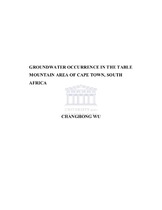| dc.description.abstract | Groundwater is an important water resource to be used to supplement the water demand for the City of Cape Town for present and future generations. Understanding the groundwater occurrence of the Table Mountain area is very important for future groundwater exploitation and management. Apart from the sea in the west, Table Mountain is mostly surrounded by the unconsolidated sediments including the Kirstenbosch, Newlands, and Oranjezicht areas. These areas are rich in groundwater resources, like springs; some of them were utilized, others not. However, there are few studies that focused on spring resource in this area. No up to date information is available for spring resources research and relative data is lacking from local research institutions. In fact, some of the spring resources in the Table Mountain area had been extracted and been utilized for local community for many years. Data and information newly obtained from this study about such groundwater resources will help future groundwater development and management. There are at least 13 springs in the selected study area. Those springs were investigated for groundwater occurrence, because spring is an important manifestation of the underlying aquifer through which groundwater dynamics can be detected. The main objective of the study was to sketch a clear picture of groundwater occurrence and to obtain an improved understanding of how geomorphology affects groundwater flow, its manifestation and quality. Water resources management is also important because this kind of water resource can be used to help meet the water demand of this local area in the future. There is relationship between the topographical features of the Table Mountain and spring occurrence. The research area delineated is used to interpret the relationship. Hydro-geochemical analysis is carried out to indicate the chemical components of the groundwater and to understand the groundwater type and water quality of this particular area. Based on the completed analysis and interpretation of factors influencing discharge and recharge, some good results were obtained and useful information is made available for first time. | en_US |

